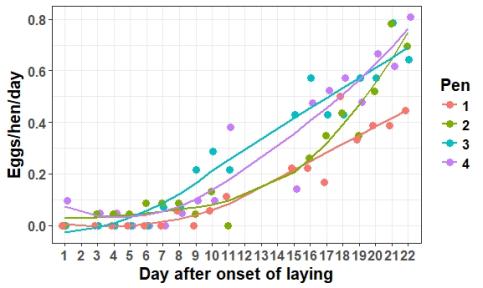Egg production
Number of eggs laid per hen

Comparison of the number of eggs laid per hen in different pens showed that there was a significant difference between pens (F=19.249, p<0.001). There was also a significant interaction between pen and day (F= 4.97, p=0.007). Visual inspection of the data shows that the number of eggs laid pen hens in pen 1 was lower for the duration of the egg collection. Pen 2, 3 and 4 appear to end up with a similar number of eggs per hen laid each day; however the trends of laying uptake are visually different for each pen. A post hoc analysis of differences between pens showed that there was a significant difference between number of eggs laid in pens; 1 and 2 (p=0.02), 1 and 3 (p<0.001), 1 and 4 (p=0.003), 2 and 3 (p=0.04), and a tendency was found between pen 2 and 4 (p=0.09). There was no significant difference in the number eggs laid per hen between pen 3 and 4 (p=0.9).
Egg weight dependent on day

The weight of eggs per day was also analysed. Visual inspection of the data shows that for each pen the weight of eggs increases over the sampling period. There is a significant difference between egg weight and the day in which the egg was laid (χ2 = 89.233, p<0.001). A post hoc analysis found a significant difference in egg weights (p<0.05) between days; 19 and 11, 20 and 10, 20 and11, 20 and 15, 21 and 10, 21 and 11, 21 and 15, 22 and 10, 22 and 11, 22 and 15, 22 and 16, 22 and 17, 8 and 19, 8 and 20, 8 and 21, 8 and 22, 9 and 21, 9 and 22.
Egg weight per pen

When comparing the egg weight per pen there was a significant difference in egg weight between pens (χ2=9.2882, p=0.03). A post hoc analysis found that there was a tendency when comparing egg weight between pen 2 and 4 (p=0.07). There was no significant difference between the other pens (p>0.05).
Responsible for this page:
Director of undergraduate studies Biology
Last updated:
05/27/18
